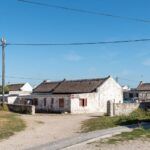Kassiesbaai fishing village
Kassiesbaai fishing village
Kassiesaai is a quiet traditional village with whitewashed thatched cottages and quaint, colourful wooden fishing boats along the bay. It is one of South Africa’s last authentic fishing villages, so named because the first dwellings there were built from”kassies’ boxes that fell from a passing ship. When the strong winds blew (as they do) the little wooden houses often blew down and had to be rebuilt.

The Kassiesbaai community was established in 1850 when the inhabitants of the fishing village were at Roman beach. They were relocated to the current site. There have been a couple of renewed attempts to relocate this due to development and the “Group Areas Act”, but after petitions and appeals to preserve a traditional lifestyle and piece of South African history, the original village is still intact. The Fisherman’s Union owns the land, which ensures its tenure and the preservation of the buildings and traditions. The houses that were built here for the fishermen are whitewashed with thatched roofs built along narrow winding streets. These houses look much the same as the first permanent stone houses built in the 1890s There are strict rules to keep the traditional ‘look’ of the dwellings. The roofs must be thatched, there are restrictions on the kinds of windows and doors that may be fitted, and walls must be either whitewashed or left bare to show the stone.


Fortunately, the traditional way of life remains largely intact. Many fishermen are sixth- or seventh-generation descendants of the original Kassiesbaai inhabitants who made their living here
The locally made open boats known as “chuckies” often go out on the ocean all night to return in the morning with yellowtail (geelstert) and redfish (rooivis) for the restaurants and dinner tables in Arniston or Cape Town.
At the beach, which is perfect for long walks, there are some rocky outcrops and an offshore beacon that you can swim out to. Sandboarding and swimming can be safely enjoyed. To the north are white sand dunes and towards the south is, the Waenhuiskrans cave, which can be visited at low tide.



